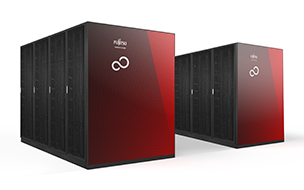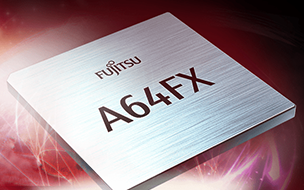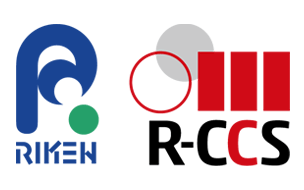
The supercomputer Fugaku, jointly developed by RIKEN and Fujitsu, was ranked No. 1 in the world in the TOP500, HPCG, HPL-AI, and Graph500 supercomputer rankings in June 2020.
Taking out top position three terms in succession, not to mention winning four categories simultaneously, represents a world first, and is testament to the outstanding performance of Fugaku. At the same time, this suggests that Fugaku can be used as an R&D platform for pursuing research into AI, big data analysis and other fields that will contribute to the Society 5.0 program championed by Japan. In fact, Fugaku has already been put to use in developing measures to address the COVID-19 pandemic.
In this interview, we invited two key persons who led the development of Fugaku to discuss the history of supercomputers and the possibilities that await in the future.
- Why do we need super high performance machines?
- The evolution of supercomputer technology and key development milestones
- Why is the race to develop Supercomputers so competitive?
- What will Fugaku make possible?
- Major obstacles in the development process
- How to expand Fugaku technology?
- Will the role of supercomputers change in the future?
- Key technologies in future supercomputer development
- New developments in supercomputing
- Education and training programs for the supercomputer engineers of the future
Why do we need super high performance machines?Tremendous computing speed brings about a qualitative shift.
It is now half a century since the first supercomputer appeared. Why do you think we need such powerful computers at all?
Matsuoka
Supercomputers are, as the name suggests, able to deliver results that are simply not possible with standard computers. In the initial stage, supercomputers were used mainly in computer simulations such as weather forecasting and ballistic calculations, and were required to reduce the time taken to process massive amounts of data.
Supercomputer performance at that time was only around ten times better than a standard computer. But the differential has since risen to the order of ten thousands to ten millions of times better. For instance, Fugaku is around 20 million times more powerful than a smartphone. Supercomputers are evolving very rapidly.
Supercomputers have helped to spawn new industries and new branches of science, and have been widely embraced in a range of fields. For example, in the field of AI, the increased capability of supercomputers has enabled new algorithms such as deep learning. Tremendous computing speed brings about a qualitative shift. Thus we can envisage increasing demand for ever more powerful computers.
The evolution of supercomputer technology and key development milestonesFujitsu's interconnect technology provided the parallel computing breakthrough that we needed
Supercomputers have evolved at a tremendous rate, leading to today's Fugaku. Tell us more about the evolution of supercomputer technology. Also, what was the most important technology in the development process?
Shinjo
Up until the 1980s, most supercomputers used vector processors. However, due to the finite processing capability of individual CPUs, there was a shift to parallel processing and scalar processing, which led to superior cost performance from the 1990s onward.
Parallel processing soon encountered a major constraint in the interconnect technology that connects the processors. In the 1990s, parallel computers could connect only a few hundred processors at most. Tofu Interconnect* was developed by Fujitsu as a way to increase the number of processors that could be used (Note 1). This was a revolutionary solution that enabled scalability on a scale of one order of magnitude greater than conventional 3-D connections by network called 6-dimensional mesh/torus. By overcoming the constraints associated with parallel interconnection, it became possible to integrate 80 thousand processors in case of the K computer, and 150 thousand for Fugaku.
- (Note1)
Why is the race to develop Supercomputers so competitive?The competitiveness of supercomputers reflects the power of the countries that make them
Fugaku was awarded first place in four rankings, including TOP500, the ranking for computational speed, which Japan had not won for nine years. Previously, American and Chinese computers had topped the TOP500 rankings. Why is the race between countries to develop supercomputers so competitive?
Matsuoka
I think the development of supercomputers has been dominated by the notions of how they are used and how they are made.
The first notion refers to how we can change the world using supercomputer applications. Fugaku aims to drive innovation in a wide variety of academic and industrial fields including state-of-art medical and drug research, disaster countermeasures, environmental protection, energy, functional materials and structural calculations for very large structures.
This leads to the second notion, of how supercomputers are made. The evolution of the supercomputer is a story of embracing cutting-edge technology and developing new technology. These technologies will permeate all areas of ICT. Elements of supercomputer technology can be scaled up to drive the next generation of cloud computing, or scaled down to IoT applications such as smartphones and robots, all of which have major implications for wider society. Today's powerful smartphones would not be possible without the evolution of supercomputers.
The abilityof a country to develop supercomputers is a reflection of its international competitiveness as well as GDP. Today the United States ranks first in global GDP, followed by China and then Japan in third place. The supercomputer performance rankings match the GDP rankings. This goes some way to explaining why the countries are so competitive.
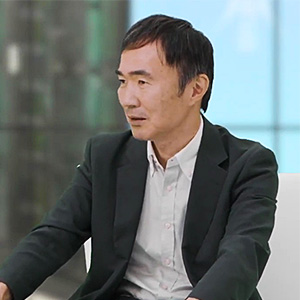 Satoshi Matsuoka, director of RIKEN Center for Computational Science (R-CCS)
Satoshi Matsuoka, director of RIKEN Center for Computational Science (R-CCS)
RIKEN
What will Fugaku make possible?Fugaku has computing power that exceeds that of all the other supercomputers in Japan put together
The computing power of Fugaku is quite incredible; for instance, it is over three times more powerful than the current second ranked supercomputer in the TOP500. With such capability, what can Fugaku do that conventional supercomputers cannot?
Matsuoka
Fugaku is about 50 to 100 times faster than the K computer. This level of computing power will bring about a quantitative shift.
Let's look at the COVID-19 pandemic as an example. Suppose we want to identify the most effective drug from more than 2,000 candidates. With the K computer it would take about a year to perform the necessary calculations, but Fugaku can do it in only three days.
A variety of strategies to combat the COVID-19 pandemic are needed. That would have required the combined computational power of all the supercomputers in Japan. The Fugaku delivers enough computational power in a single unit.
The development of the Fugaku was underpinned by nine key scientific and public challenges in areas such as realization of healthy longevity in society, disaster mitigation, environmental protection and energy supplies. Applications were developed in parallel under a co-design model. This made it possible to adapt such applications for faster problem-solving in relation to COVID-19 despite the Fugaku being put to use earlier than planned.
Major obstacles in the development processThe "impossible" moonshot target for power performance
As you have already mentioned, Fugaku was not due to start operations until FY2021; however, some of the resources have already been in use for COVID-19 measures since 2020, with promising results. What obstacles or difficulties did you encounter in the development of Fugaku?
Shinjo
The most difficult challenge was to boost performance without increasing power consumption too much. The development process was constrained by the 30 MW capacity of the Center for Computational Science at RIKEN.
To this end, a minimum performance target of 15 GFLOPS/watt was defined at the outset. At that time, the most power efficient supercomputers in the world were delivering power performance of 2 - 3 GFLOPS/watt, so 15 GFLOPS/watt was seen as impossible.
Moreover, it was very difficult to deliver the required power performance across a range of applications. We overcame this challenge by adopting new implementation technologies and introducing high-efficiency cooling systems, as well as the improvement semiconductor performance.
Production of the Fugaku was planned to begin in around December 2019, with completion of delivery in May 2020. However, some of the components were sourced outside Japan. With factories and logistics disrupted by the COVID-19 pandemic we had to revise the production schedule constantly, but happily we were able to get it completed on time.
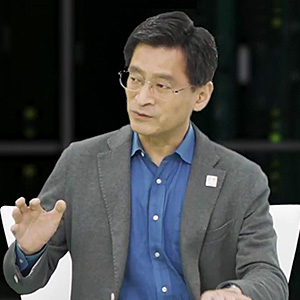 Naoki Shinjo,
Naoki Shinjo,
Corporate Executive Officer
Fujitsu Limited
Matsuoka
Regarding the power performance, I would add that 15 GFLOPS/watt was seen as a moonshot, a nonsensical target. The CPUs currently used for cloud computing deliver about 5 to 6 GFLOPS/watt, approximately one third of that of Fugaku. To achieve the same performance as Fugaku would require up to 100 MW of power, enough to warrant a dedicated power plant. The general-purpose CPU used in Fugaku has power performance of 15-GFLOPS/watt, which is one of the world's top power efficiency, incredible power performance. I think we did a really amazing job with the Fugaku.
How to expand Fugaku technology?To expand as commercial supercomputers
The Fugaku development was a national project. I believe one reason for that was to encourage deployment in the global arena. What is Fugaku used for?
Shinjo
Fujitsu has launched a commercial supercomputer, PRIMEHPC FX1000, which uses the same technology of Fugaku. This version is used by academia such as JAXA (Japan Aerospace Exploration Agency) and Nagoya University and in the manufacturing sector (most notably by Canon).
The PRIMEHPC FX1000 is designed for large scale computer centers at a similar level to the Fugaku. As such it may not be suitable for smaller clients. The PRIMEHPC FX700 is designed as a slightly more user-friendly model. It has a compact form factor similar to standard cloud servers, and is suitable for clients in a wide range of fields.
Meanwhile, the all-new A64FX CPU offers incredible power efficiency. This CPU has been adopted by our global partner HPE (formerly Cray Inc.) for use in its supercomputers, and is used all around the world.
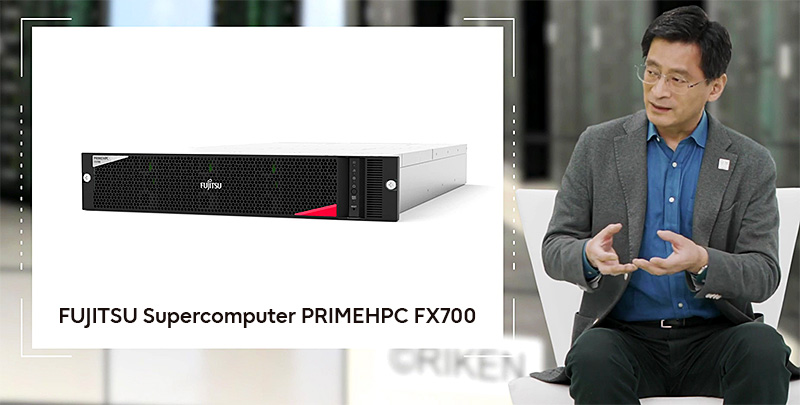
Will the role of supercomputers change in the future?Driving innovation in every aspect of society
The performance of Fugaku far surpasses that of past supercomputers. Going forward, do you think the role of the supercomputer will change as we see more and more powerful supercomputers appear?
Matsuoka
The name Fugaku signifies both height and a broad base.
In May 2020, Microsoft announced plans to deploy its AI development via supercomputer. This is just one example of how novel uses for supercomputers can drive major innovation initiatives in businesses. It will be increasingly necessary to apply world top-class supercomputers to AI, self-driving vehicles, home security systems and other complex projects. Competition is increasingly fierce not just between countries but among companies.
With respect to the broad base, A64FX is suitable for a range of uses since it is an Arm CPU. The multi-purpose A64FX CPU combines versatility, powerful performance and low-energy operation.
We are on the verge of a new era, dubbed Society 5.0, where ICT has transformed the world and improved lives everywhere and supercomputers and associated technologies are part of the fabric of society.
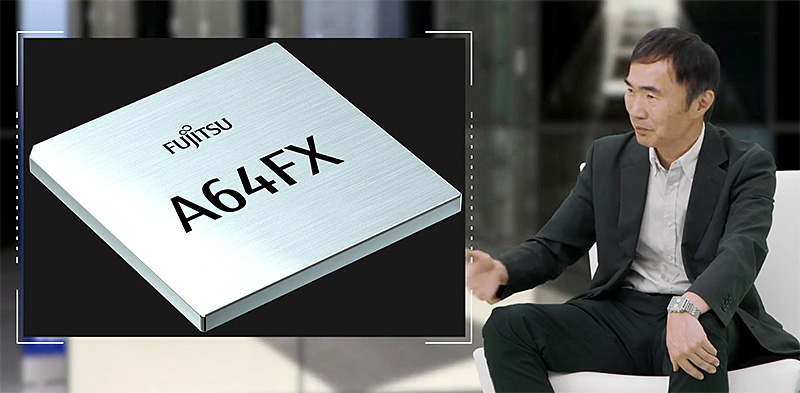
Shinjo
It is well known that supercomputers are used for weather forecasts. Supercomputers are now being used in a range of fields related to public infrastructure, such as vehicle impact analysis and air flow simulations. Japanese companies, however, have been slower to embrace supercomputers. Once supercomputers are established in these fields, they will be embraced more widely, to the point where we are no longer aware of their presence.
Matsuoka
To this end, it is important that supercomputers are not only fast but user-friendly as well. Also, there needs to be a wide range of software available. The popularity of personal computers and smartphones can be attributed to the software ecosystems that have come with them. This is why the Arm architecture was chosen for Fugaku. For supercomputers to be widely used, it is important that they offer not only superior performance but also versatility and an extensive ecosystem.
Recently, we have been fielding many inquiries from companies asking for specific applications. Increasingly, supercomputers are able to solve most issues.
Key technologies in future supercomputer developmentDemand for computing power continues to rise
What do you think are the key technologies that will feature in the development of supercomputers going forward?
Shinjo
Based on discussions with numerous developers about the computing power that would be required for Fugaku, it seemed that the expectations around computing power would be virtually impossible to achieve. The level of computing power envisaged is enough to produce a total paradigm shift. In this sense, I believe that supercomputers will need to become even more powerful in the future.
Quantum computers are a hot topic at the moment. It should be noted, however, that quantum computers operate on a completely different set of principles to supercomputers. Supercomputers have to inherit the architecture of the current computer in order to utilize existing software assets. One of the key challenges is to resolve the limitations imposed by transfer speeds between increasingly fast CPU chips and external memory and interconnect technology.
Matsuoka
Fugaku is a parallel computer with nearly eight million CPU cores.
The A64FX CPU combines the properties of both vector and scalar processors to deliver faster performance than rival CPUs.
Vector processors require massive increases in memory and network bandwidth to work effectively. The A64FX boasts vastly superior performance compared to standard memory devices, thanks to the use of high-speed HBM memory as featured in the state-of-art GPUs.
Going forward, the development of supercomputers will face two major challenges.
One is the need to expand bandwidth further. Without this, many applications will hit a ceiling.
The other is the end of Moore's Law. If we cannot reduce transistor size any further, then computing power will also hit a ceiling. So how will we be able to improve the computing power of supercomputers? This is where we will see the limitations of conventional approaches. And this is where the great challenge lies.
New developments in supercomputingFugaku is a game changer
I expect the arrival of Fugaku will drive new trends in computing. What are your thoughts on this point?
Matsuoka
Supercomputers are steadily becoming more versatile. This became obvious to all when Fugaku achieved the world No. 1 status using general-purpose CPUs. Fugaku has played a role of a game changer.
Supercomputers have traditionally been seen as otherworldly, but Fugaku is essentially an enormous cluster of Arm CPUs designed to run standard Red Hat Linux. The "look and feel" of supercomputer software is increasingly indistinguishable from ordinary computer software.
How do we use the new, more accessible high-performance parallel computers? Supercomputers are now being used in ways that we could never have envisaged.
Let me give you an example. There is a rich natural language processing model, called GPT-3. This model was only made possible by extensive deep learning training using a massive supercomputer designed specifically for AI. However, if a supercomputer like Fugaku is available publicly, many research groups can make use of its computing power for innovative research work. Our survey identified a wide range of projects and concepts that researchers are hoping to try using Fugaku.
Education and training programs for the supercomputer engineers of the futureWe need a change of mindset in programming
Matsuoka
The annual Supercomputing Contest (SuperCon), a programming contest for high school students, is an initiative of the Tokyo Institute of Technology and the University of Osaka. The event was canceled in 2020 due to the COVID-19 pandemic, and in its place was an online event involving Fugaku.
High school students are increasingly proficient in ICT skills such as programming and building computers from parts.
Fugaku is based on Arm processors, so at first glance it looks like a standard computer; but for the students there was one big difference: they had no experience in coding and algorithms for parallel computing.
Those teams that understood parallelization algorithms and could adapt their programming accordingly performed better than those who did not. I imagine it was a new intellectual challenge for many of them.
The training programs of the future will need to focus on programming and parallel processing algorithms, and how these are applied in fields such as AI, simulation and so on.
If we can provide motivated young people with opportunities to have hands-on experience with supercomputers, we should soon see young engineers who can easily handle machines with 100,000 nodes.
Shinjo
Motivation is important for development engineers. Motivation comes from understanding the significance of their work and being provided with positive feedback.
Being involved in developing a machine like Fugaku means being part of the bigger picture of creating world-leading technology. And if the completed machine gains global recognition, then we can also feel a sense of accomplishment.
We aim to develop engineering talent by focusing on these forms of motivation.
By achieving the world No. 1 status using general-purpose Arm architecture CPUs, Fugaku has opened up a new horizon in the world of supercomputers. We hope that this discussion today has shown that Fugaku will become essential infrastructure for solving social issues and driving innovation in the private sector. Fugaku is bound to achieve great things.
- (Note)Product names and other names in this document are trademarks or registered trademarks of their respective owners.
- (Note)This article is based on an October 2020 discussion session at Fujitsu ActivateNow.

